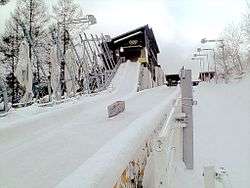Spiral (bobsleigh, luge, and skeleton)

The Spiral is a bobsleigh, luge, and skeleton track located in Iizuna village, located north of Nagano, Japan. Used for the bobsleigh and luge competitions for the 1998 Winter Olympics, it is the only permanent bobsleigh, luge, and skeleton track in Asia and the only one of its type in the world with two uphill sections. It is officially referred to as the Nagano Bobsleigh-Luge Park in Japan.
History
The track was among part of the venues used for the 1998 Winter Olympics that was started in 1990.[1] Construction on the track started in November 1993 and was completed in March 1996 with homologation from the International Bobsleigh and Tobogganing Federation (FIBT) on 28 March 1996 and from the International Luge Federation on 24 June 1997.[1][2][3] This track was referred to as the "Spiral" because of the winding track and dynamic movement of the sleds.[1]
Track technical details
Overall track construction cost ¥ 10.1 billion.[1] The course was constructed in conformance of the natural topography of Mt. Iizuna.[1] Three indirect ammonia refrigeration systems are located along the track, limiting the amount of ammonia to be under 800 kg (1,800 lb). During construction, rocks and trees that were dug up were used as materials to build settling ponds and a retaining wall to prevent landslides. Topsoil that had been removed during construction was returned to the site once groundwork was completed. About 40,000 saplings, mainly beech and oak, were planted two per square meter, as part of the environmental stewardship committed during the Winter Games.[1]
To help with ice making techniques, Nagano Organizing Committee officials recruited Ralf Mende, who works for the bobsleigh, luge, and skeleton track in Altenberg, Germany [4] to train staff to make proper ice.[1] Mende and his crew worked 18 hours a day during the 1998 Games to ensure track thickness was 2–3 cm (1–1 in) of ice.[4] Sun shades are used in an effort to maintain the operating temperatures of −10 to −15 °C (14 to 5 °F).[4] Track competitions were also moved to the afternoon during the games to avoid the sunniest hours.[4] There are a total of 56 sensors located throughout the track to maintain constant ice temperature and thickness.[2]
Statistics
| Sport[1] | Length (meters) | Turns | Vertical drop (start to finish) | Average grade (%) |
|---|---|---|---|---|
| Bobsleigh and skeleton | 1360 | 14 | 113 | 8.64[5] |
| Luge - men's singles | 1326 | 14 | 114 | |
| Luge - women's singles/ men's doubles | 1194 | 13 | 96 |
There are no listed turn names for the track. The track's two uphill sections are right after turn 8 with an average uphill inclincation close to 4% and between turns 10 and 11 with an average uphill inclination of nearly 10%.[3]
| Sport | Record | Nation - athlete(s) | Date | Time (seconds) |
|---|---|---|---|---|
| Luge - men's singles | Track | David Möller - |
13 February 2004 | 48.813 |
| Luge - women's singles | Track | Silke Kraushaar - |
14 February 2004 | 49.744 |
| Luge - men's doubles | Track | |
14 February 2004 | 49.279 |
Championships hosted
- Winter Olympics: 1998
- FIBT World Championships: 2003 (Men's and women's skeleton)[7]
- FIL World Luge Championships: 2004[8]
References
- 1 2 3 4 5 6 7 8 1998 Winter Olympics official report Volume 2. pp. 184-5, 226-9.
- 1 2 Shinmai.co.jp article on the Spiral track for the 1998 Winter Olympics. - Accessed 4 February 2008.
- 1 2 Shinmai.co.jp 20 January 1998 article on the two uphill sections of the Spiral. - accessed 5 February 2008.
- 1 2 3 4 Shinmai.co.jp article on the icing requirements for the Spiral prior to the 1998 Winter Olympics. - accessed 5 February 2008.
- ↑ FIBT track profile
- ↑ USALuge.org tracks. - Click on Nagano, Japan track and scroll down for track records on luge track records. Accessed 5 February 2008.
- ↑ FIBT men's skeleton world championships results since 1989
- ↑ FIL World Luge Championships men's single results since 1955
External links
- FIBT track profile - Image is from a skeleton racer perspective shown at night. Men's single luge intersect prior to turn one while the luge - women's singles and men's doubles intersect prior to turn two.
- FIL-Luge track profile
- Official website (Japanese)
Coordinates: 36°42′39″N 138°9′27″E / 36.71083°N 138.15750°E

